Customer Support
Call Center Automation Guide: How It Works, Key Benefits, and Proven Use Cases

Table of Contents

Imagine being a call center agent juggling multiple customer requests, disconnected systems, and endless data; all while calming frustrated callers. If you’re wondering why agent turnover rates are so high, this is why.
Using AI and machine learning, to automate repetitive inquiries and give customers an easy way to self-service is one of the most effective ways to make agents’ work-life easier and solve information and call overload.
AI has the potential to transform agent experiences. Webex predicts that by 2025, 96% of human agents in AI contact centers will handle only specialized tasks.
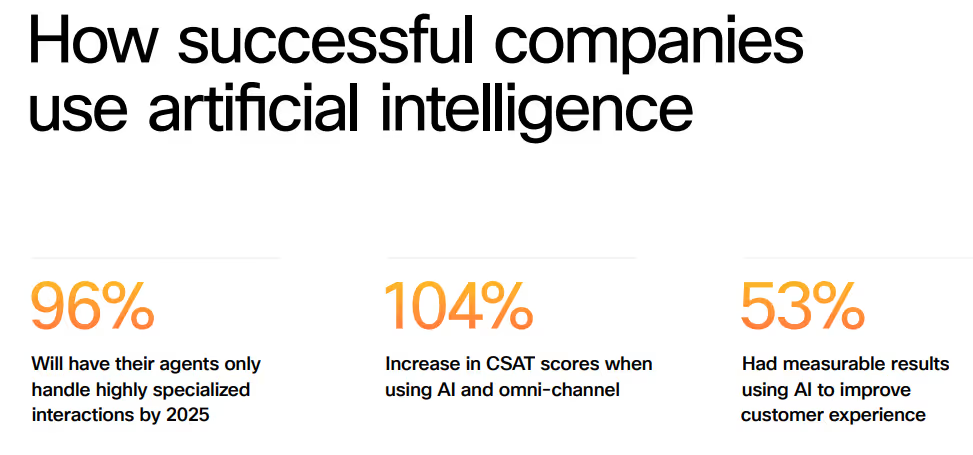
Artificial intelligence is now more powerful, relevant and practical than ever. Virtual agents such as chatbots, conversational AI IVR and intelligent assistants help to minimize agent burnout, while improving the quality of the time spent with customers who need help from a human agent.
In this blog, we'll explore how CX leaders are driving customer relationships through call center automation, its applications, supporting technologies, and examples of real-world deployment.
The future of AI-driven contact center automation
Recognizing The Problem
Call centers have long been a touchstone for organizations’ customer experience (CX). It’s often one of the first interactions; customers have with a brand.
According to Forrester, 98% believe their contact centers have a significant impact on their ability to improve CX.
Despite recognizing the contact center’s ability to deliver on business objectives, the performance of the contact center continued to decline. We found that companies grapple with the following:
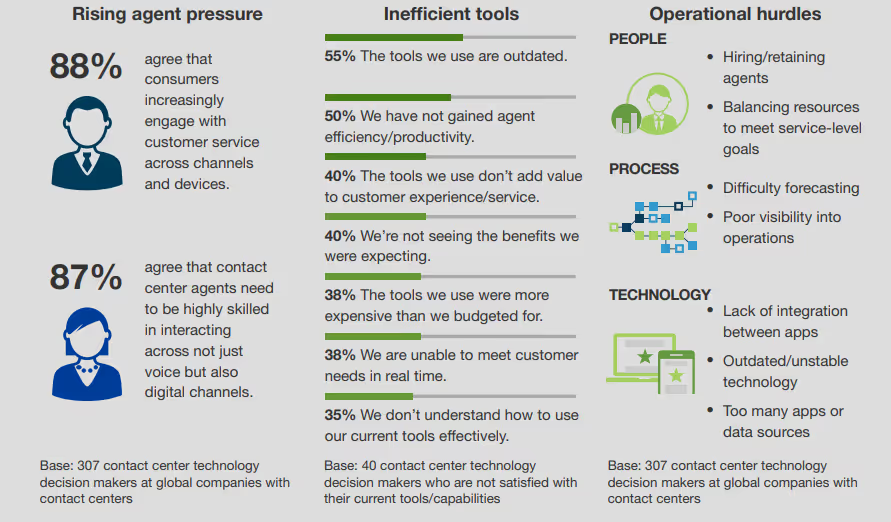
- Rising pressure on agents: The vast majority 88% of contact center technology decisions agree or strongly agree that consumers increasingly engage with customer service across channels and devices. With this increase in interactions, contact center agents are left to handle requests for service across different channels.
- Inefficient tools and capabilities: The growing number of communication channels and touchpoints is making good service hard to deliver. Only 31% of respondents say they are fully satisfied with the tools in their contact centers. The majority, feeling unprepared, attribute this dissatisfaction to outdated tools that fall short of meeting the needs of their business, customers, and agents.
- Operational hurdles: Regardless of firmographics, 95% of companies across the globe face challenges. Contact centers continue to face persistent challenges across three key areas: people (recruiting and retaining agents, managing resources to meet service-level targets), processes (inaccurate forecasting, limited operational visibility), and technology (outdated or unstable systems, lack of integration, and an overload of disconnected applications and data sources).
To stay competitive, these challenges must be addressed with scalable solutions.
The solution
The benefits of AI are well-known. Automation in the call center streamlines inquiry capture and resolution. It optimizes case routing, schedule management and classification. AI agents extract useful information from voice and digital conversations to quickly understand issues and customer sentiment that may affect customer retention and loyalty.
What Is Contact Center Automation?
Contact center automation replaces human involvement in routine support workflows with AI-driven systems. These systems handle call routing, customer verification, ticket creation, post-call tasks, and follow-ups without human input.
Benefits of Contact Center Automation
Here are some of the benefits customers, agents, and businesses realize as a result of AI applications in call centers:
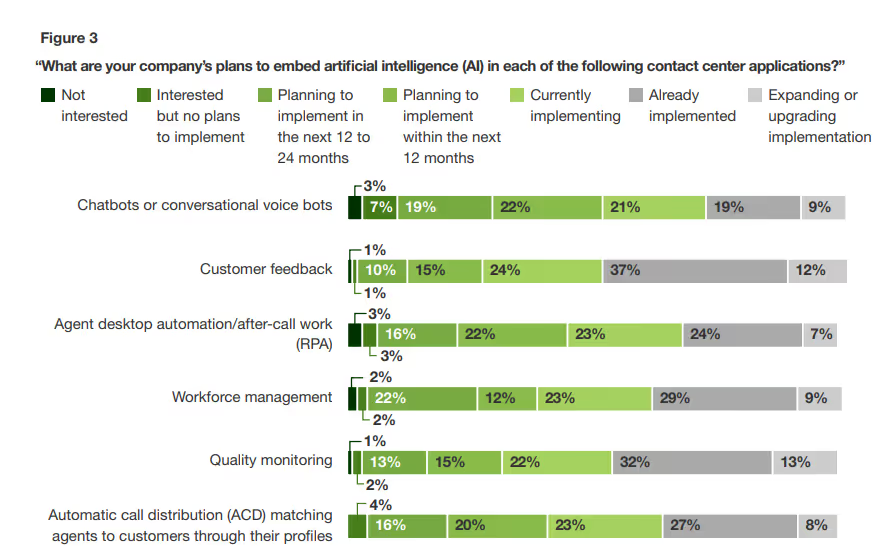
Increasing self-service and reducing the need for agent assistance
Research shows that 80% of respondents agree that automation helps their contact centers increase agentless interactions. So, while AI will handle simpler, repetitive transactions, agents can focus on complex, higher-value interactions that require advanced skills and additional time to resolve. Also, agents prefer to spend their time on more impactful interactions than provide repetitive service for easy issues.
Gaining an edge over competitors
According to Forrester, 79% of businesses say that AI would enable them to have the upper hand over competitors as they deliver timely and contextually relevant customer experiences. Research also reveals a statistical correlation between more engaged employees and revenue growth. Just a 5% improvement in employee engagement leads to a 3% increase in revenue.
Improving customer interactions with agents
Close to 75% believe that AI improves customer service in the contact center. Enhancing QA teams with AI gives companies more time to focus on coaching and training agents. At the same time, advanced routing capabilities ensure customers are connected with the most suitable agents, leading to better issue resolution.
Delivering 24/7 support without extra staffing
AI voicebots and IVRs stay online day and night, including weekends and holidays. This ensures consistent service levels across time zones without increasing agent headcount or paying overtime.
Increasing first call resolution (FCR)
AI systems understand customer intent in real time and direct them to the right solution or person. This avoids unnecessary transfers and repeat calls, which improves satisfaction and reduces ticket volume.
Cutting operational costs per call
Each automated call costs significantly less than a human-handled one. Businesses save on salaries, training, and infrastructure while scaling up support coverage.
Eliminating after-call tasks
AI tools can summarize conversations, update CRM records, and trigger follow-ups automatically. This removes several minutes of manual work after each call and helps agents move on quickly.
Reducing human errors
With AI pulling data directly from connected systems, there’s less risk of typos, missed updates, or incorrect entries. This improves accuracy and data consistency across platforms.
Improving agent focus and job satisfaction
Agents deal only with escalated or complex cases instead of repeating the same answers all day. This improves engagement, reduces burnout, and increases the number of meaningful conversations per shift.
According to Forrester, businesses will increasingly leverage AI to drive efficiency and deliver more impactful customer experiences. AI will play a key role in monitoring customer journeys and engaging proactively at the right moments to increase revenue and conversion rates.
Technologies that improve content center automation (Types of Call Center Automation)
Automation helps businesses resolve queries faster, cut down on costs, and reduce human error. In the end, it's a win-win for happier customers, more productive agents, and a stronger business.
Here are some of the most common automation technologies:
Chatbots and voice agents
Chatbots and voice agents don't replace human phone agents–they augment them. By handling routine calls, they free up agents to solve complex issues Instead of manually handling every call, AI agents work alongside to deliver faster, more intelligent and context-aware phone support. AI-first voice models aim to unify interactions across platforms, enabling seamless continuity across phone conversations.
Robotic Process Automation
Robotic Process Automation, or RPA, automates the routine, repetitive and operational tasks of a call center, freeing up human agents to focus on more complex and valuable customer interactions. Embedded into several call center solutions, the technology improves operational efficiency.
Here are the following use cases of how it does so:
- Updating new information into the system or opening a new ticket to fix the client’s issue.
- Placing or changing an order
- Self-service RPA bots to provide real-time assistance to customer’s queries
- Real-time quality management of the supervisor
- Ticket management
- Payment processing
- Data migration across systems
AI call routing
AI call routing directs inbound callers to the best agent or calls queue according to predefined custom rules, the caller's IVR input, and current call center conditions through the power of artificial intelligence.
AI call routing dramatically reduces call hold times by immediately connecting callers to the nearest available agent or letting them schedule a callback. It also prevents customers from having to repeat themselves to multiple agents–which is the most frustrating part of an experience.
Predictive analytics and customer insights
Hyper-personalization is the most advanced way brands can tailor their communication to individual customers. It’s done by creating custom and targeted customer experiences through the use of data, analytics, AI, and automation.
Most automation platforms offer call center insight that can be used to monitor and analyze customer interactions across various channels, including calls, chats, and emails. Call centers can leverage predictive analytics to forecast customer needs and behaviors. This proactive approach allows for personalized service and can help agents anticipate and address potential issues before they escalate.
Overcoming challenges in AI-driven contact center automation
Even with a clear understanding of the critical need for AI, there can be obstacles to its adoption. To ensure success, you may need to take the time to educate different stakeholders within your organization on its benefits and reassure your staff that the role of AI is to enhance, not replace, their job:
The Myth: "AI will replace human agents, causing job losses."
AI in call centers is designed to support, not replace, human agents. While it automates routine tasks, the need for human touch, complex problem-solving and empathy remains vital. Customers value personal connections and nuanced understanding, which AI cannot replicate.
Ultimately, AI’s goal is to increase human agent’s efficiency by taking over simple tasks, allowing them to focus on more valuable work.
The Myth: "Heavy reliance on AI leads to impersonal interactions."
Harvard Business Review quotes the major challenges customers face when contacting a customer service organization, are:
- 56% have to re-explain an issue
- 57% have to switch from web self-service to a phone interaction
- 59% say resolving their issue requires moderate to high energy expenditure
- 59% are transferred to another specialist
- 62% have to contact the provider repeatedly to resolve the issue
AI improves human interactions to direct phone calls to the right person or department quickly and efficiently. Rather than making interactions impersonal, AI empowers agents to deliver more meaningful and relevant support.
The Myth: "AI Is Too Expensive for Businesses."
While the initial investment in AI can be significant, the long-term benefits often weigh down the cost. As AI technology advances, it becomes more accessible and affordable for businesses of all sizes.
- Enhanced Efficiency: Decreased handle time by 20%, resulting in annual cost savings of $150,000.
- Boosted Customer Satisfaction: Improved customer satisfaction scores by 10%, contributing to an additional $250,000 in annual sales.
- Lowered Costs: Reduced agent turnover by 15%, generating yearly savings of $75,000.
Real-world use cases of AI-driven contact center automation
In many industries, companies are using contact center automation to eliminate manual tasks during and after calls. AI tools now handle identity verification, update ERP systems with new customer details, log tickets automatically, and send follow-up confirmations or summaries. These workflows reduce errors and save hours of agent time each week.
Below are the top use cases demonstrating how AI solutions transform customer support across industries.
Insurance
Insurance businesses face mounting pressure to enhance customer experiences while cutting costs. The use of conversational AI in the insurance industry empowers insurers to provide personalized experiences, enhance operational efficiency, and reduce costs.
- 24/7 customer support & query resolution: When it comes to response time, the golden time is five minutes or less. If not, the chances of converting can drop by 400%. AI voice bots offer immediate assistance, reducing drop-off rates and improving satisfaction. For example, answering questions like "What does my premium cover?", “How to claim my insurance money?”, etc.
- Fraud detection: AI voice agents can quickly analyze data connections to detect fraud, even in complex schemes. They can identify accounts that share suspicious details, track down accounts linked to fraudsters, and uncover links that lead to them.
- Proactive renewal and upsells: With the AI Agent's omnichannel capabilities, customers can respond directly to confirm renewals or ask questions, bypassing the pitfalls of traditional channels like email. Unlike email, where customers might miss or ignore reminders, an AI-driven, interactive approach ensures better engagement and reduces the chance of missed renewals.
Healthcare
According to SpruceHealth, a typical healthcare provider handles 53 patient calls per day and spends 66 minutes of phone call overhead per day. Medbelle, a leading healthcare provider across the UK, has shared that manual processes lead to patients waiting 1-2 days for an answer to simple queries.
With the rise of conversational AI technology, tools like AI voice bots are transforming these time-consuming processes, offering instant, scalable solutions for patient interaction.
- Appointment scheduling: AI can automate the repetitive tasks of appointment management, ushering in a new level of efficiency. With an AI appointment setter powered by conversational AI, businesses can easily handle scheduling, rescheduling, and cancellations while minimizing manual input and reducing the risk of human error.
- Patient care management: AI allows patients to quickly request prescription refills, view test results, and access detailed information about their medications. By providing this information conveniently, conversational AI enhances patients' sense of autonomy and control, encouraging active participation in their healthcare journey through human interactions.
- Information gathering & document retrieval: AI can engage in one-on-one interactions with patients, gathering all necessary information during the conversation. Through seamless integration with the organization's systems and processes, the AI can access existing records or generate new documentation to update patient files or create new cases.
E-commerce
Conversational AI opens a variety of use cases within e-commerce. Thanks to Machine Learning and Natural Language Processing (NLP), today's bank chatbots are seen as scalable tools that enhance customer experience and increase operational efficiency.
- 24/7 personalized assistance: One of the standout benefits of AI chatbots and voice bots is their 24/7 availability. This availability is helpful for getting answers, resolving issues, or addressing complex queries at any time. In fact, research by the Economist says that personalized assistance is considered the most valuable use of artificial intelligence for banks.
- Payments and transaction reminders: AI answering services are increasingly being integrated into banking systems to automate the process of payment processing and reminders. They are capable of sending reminders through various channels, including SMS, voice calls and emails, ensuring that customers are constantly informed about upcoming or overdue payments.
- Accounts management: AI automates routine and repetitive questions, thus reducing the need for human interactions. Customers no longer need to run to the bank for common services such as checking bank balances, transferring funds, managing cards, etc.
Synthflow AI voice agent: The foundation of contact center automation
Call center automation is a journey, not a destination. If you aren’t taking advantage of these call center automation trends, you might be missing out on a lot of opportunities.
With Synthflow AI, you can streamline many processes and operations. Here’s an overview of what you can automate with Synthflow:
- IVR and custom call routing: Synthflow AI provides a multi-level Interactive Voice Response system and custom call routing rules, so your calls are routed to the right destination–reducing call transfers and ensuring high FCR rates.
- AI chatbots: Synthflow’s AI chatbot can support your customers 24/7, answer FAQs, and help them resolve basic issues without needing to interact with your human reps.
- No-code infrastructure: Synthflow's no-code, drag-and-drop interface allows users to set up a voice agent in minutes without needing any technical knowledge or coding ability. It can seamlessly handle a large volume of calls across all timelines and languages.
- Integration capabilities: Synthflow AI offers integration capability to some of the most powerful integration capabilities, including Hubspot, GoHighLevel, Zapier, ClickFunnels,Cal.com and Make.com. Plus, businesses can use Zapier to access over 7,000 apps and save time on scheduling, lead generation, and more.
- Telephony options: Synthflow AI supports SIP trunking, Twilio, webcalls, and Bring Your Own Carrier (BYOC), offering flexibility in how you set up and manage your voice infrastructure.
- Multilingual language: Synthflow offers support for 90+ languages, enabling businesses to connect with global audiences seamlessly.
Sign up for a free demo and discover how Synthflow can modernize your contact center operations.

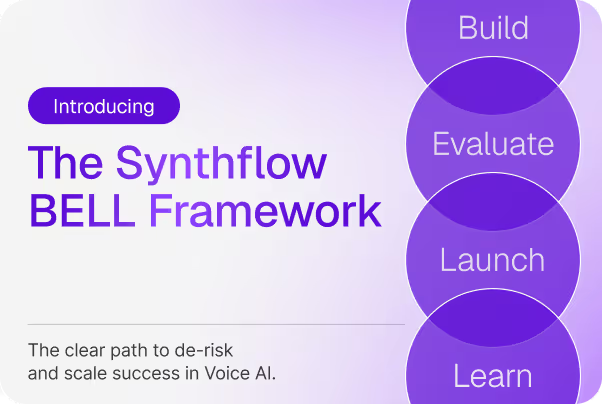
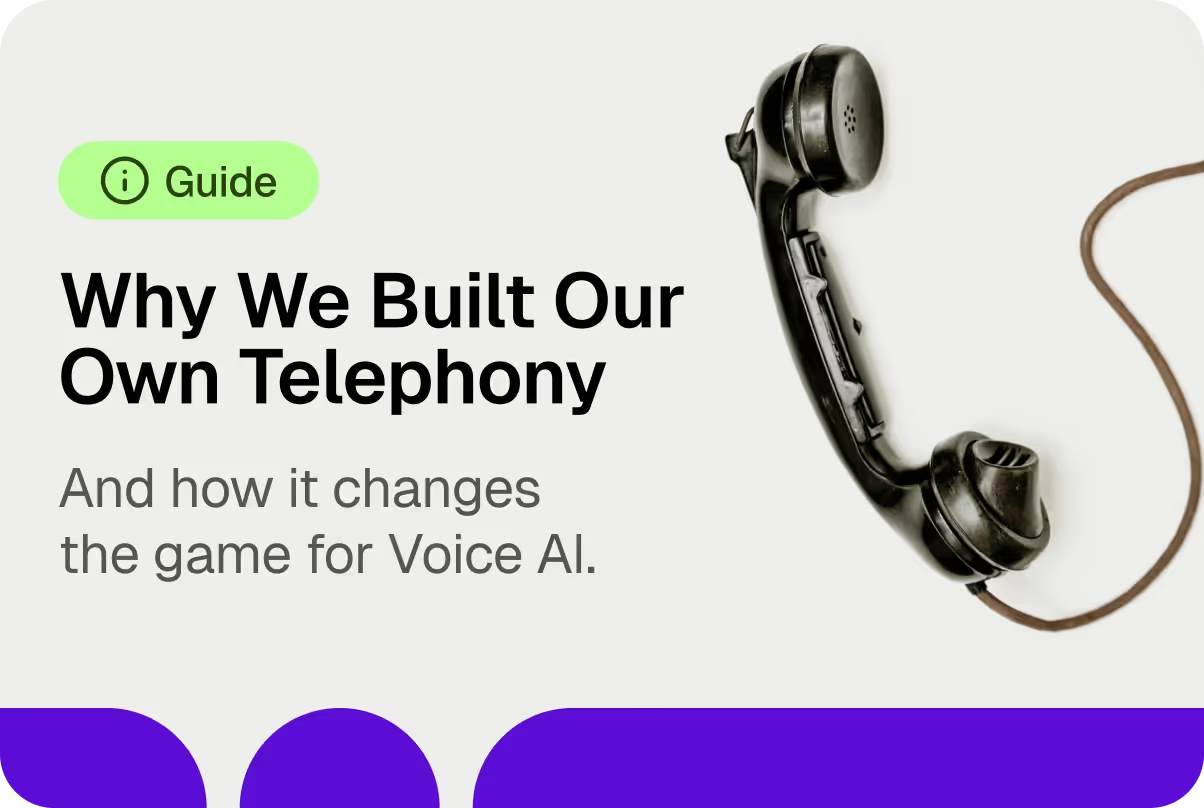
.avif)